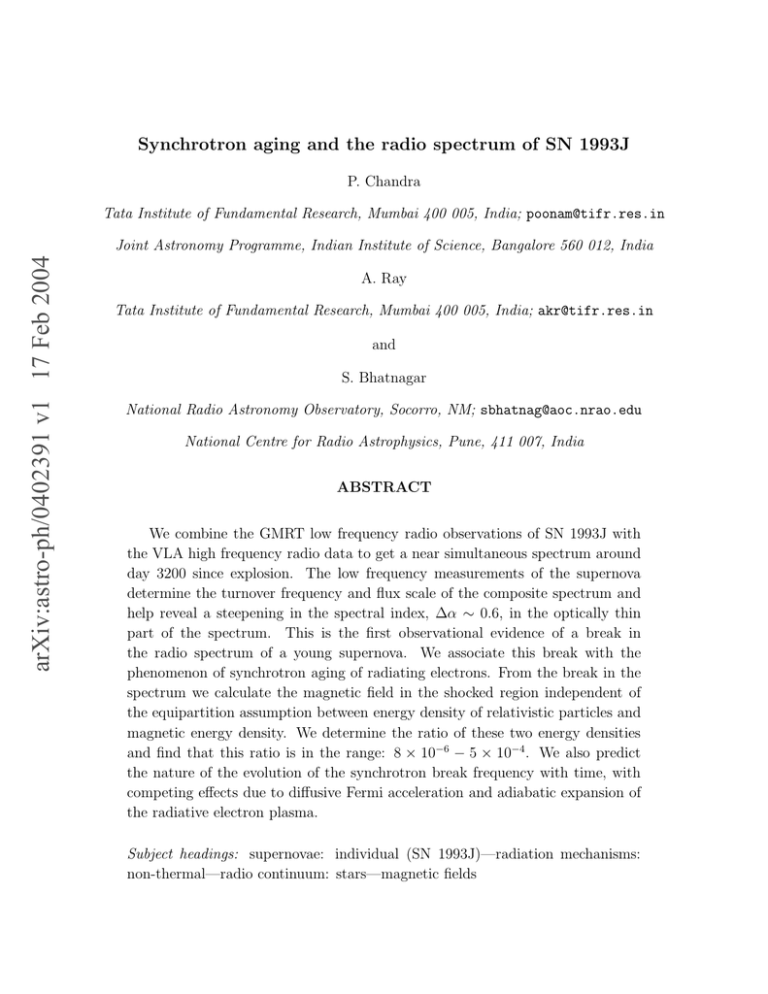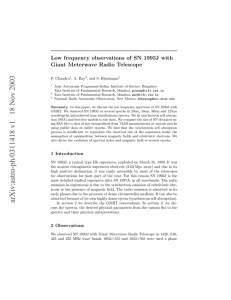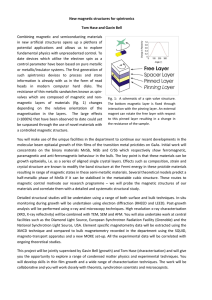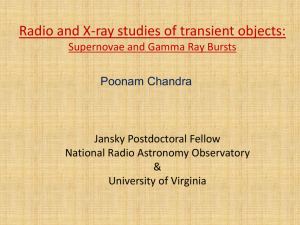Synchrotron aging and the radio spectrum of SN 1993J
advertisement

Synchrotron aging and the radio spectrum of SN 1993J P. Chandra Tata Institute of Fundamental Research, Mumbai 400 005, India; poonam@tifr.res.in arXiv:astro-ph/0402391 v1 17 Feb 2004 Joint Astronomy Programme, Indian Institute of Science, Bangalore 560 012, India A. Ray Tata Institute of Fundamental Research, Mumbai 400 005, India; akr@tifr.res.in and S. Bhatnagar National Radio Astronomy Observatory, Socorro, NM; sbhatnag@aoc.nrao.edu National Centre for Radio Astrophysics, Pune, 411 007, India ABSTRACT We combine the GMRT low frequency radio observations of SN 1993J with the VLA high frequency radio data to get a near simultaneous spectrum around day 3200 since explosion. The low frequency measurements of the supernova determine the turnover frequency and flux scale of the composite spectrum and help reveal a steepening in the spectral index, ∆α ∼ 0.6, in the optically thin part of the spectrum. This is the first observational evidence of a break in the radio spectrum of a young supernova. We associate this break with the phenomenon of synchrotron aging of radiating electrons. From the break in the spectrum we calculate the magnetic field in the shocked region independent of the equipartition assumption between energy density of relativistic particles and magnetic energy density. We determine the ratio of these two energy densities and find that this ratio is in the range: 8 × 10−6 − 5 × 10−4 . We also predict the nature of the evolution of the synchrotron break frequency with time, with competing effects due to diffusive Fermi acceleration and adiabatic expansion of the radiative electron plasma. Subject headings: supernovae: individual (SN 1993J)—radiation mechanisms: non-thermal—radio continuum: stars—magnetic fields –2– 1. Introduction The radio spectrum of a young supernova probes the conditions in the magnetized plasma where this radiation originates from relativistic electrons, which are believed to be accelerated in the interface region of the supernova blast-wave shock and the circumstellar medium. The radio emission from the nearby supernova SN 1993J is clearly of a non-thermal nature and is argued to be due to synchrotron radiation in a magnetic field amplified in the interaction region and affected by synchrotron self absorption and external free-free absorption (see e.g.Fransson & Bjornsson (1998) and references therein). The most critical parameter of the plasma which affects the synchrotron radiation spectrum, is the strength of the magnetic field. This is often estimated indirectly under assumptions of equipartition of energy between the magnetic fields and that of relativistic particles or by fitting the radio flux density and turnover wavelength. In many classical radio sources, such as supernova remnants (SNRs) like the Crab or Cassiopeia A, or in luminous radio galaxies, the radio spectral index is found to steepen at high frequencies (see e.g. Kardashev (1962); Eilek et al. (1997); Myers & Spangler (1985)). This is due to the so called synchrotron aging of the source, as during the lifetime of the source, electrons with high enough energies in a homogeneous magnetic field will be depleted due to efficient synchrotron radiation compared with the ones with lower energies. An observation of a synchrotron break can yield a measurement of the magnetic field independent of the equipartition argument if the age of the source is known (magnetic field in the crab nebula was measured by Pikelner (1956) (as quoted in Shklovskii (1960)) using this technique). Multi-frequency radio studies of a supernova like SN 1993J, that is bright enough in the radio bands can offer such a possibility. SN 1993J exploded on March 28, 1993. It was the archetypal type IIb supernova and provided a good opportunity to study the extragalactic supernovae in detail for being the nearest extragalactic supernova (3.6 Mpc). In this paper, we discuss the near simultaneous spectrum of SN 1993J obtained by combining the GMRT low frequency data with the VLA high frequency data around day 3200 since explosion. We find a steepening of the spectrum by ∆α = 0.6 at radio frequency of 4 GHz. We associate this break with the synchrotron cooling. Synchrotron aging of young supernovae has been discussed by Fransson & Bjornsson (1998) and also mentioned by Perez-Torres et al. (2002). However we find the first clear observational signature of a spectral break in radio bands of the young supernova SN 1993J. With this break frequency and the independently known age of the SN 1993J, we determine the magnetic field in the supernova. Moreover, we predict how this break frequency will evolve with time, based on a quasi-static evolution of the electron spectrum under the combined effect of acceleration processes, synchrotron losses and adiabatic expansion of the shell where the electrons are confined. We compare this observationally determined field with the best fit magnetic field under equipartition –3– assumption and thence derive the fraction by which relativistic energy density deviates from magnetic energy density. We briefly describe the observations of SN1993J in section 2. In section 3 we combine the data with the VLA data and explore spectral fits with and without synchrotron cooling breaks. In section 4 we explore the cumulative effects of adiabatic expansion of the supernova envelope and energy gain undergone by electrons under diffusive particle acceleration upon the synchrotron cooling affected particle spectrum. In section 5 we discuss the evolution of the break frequency with time and the importance of wide-band spectra for modeling. 2. GMRT Observations We observed SN 1993J with the Giant Meter-wave Radio Telescope in 610 and 235 MHz wavebands on 2001 December 30 and in 1420 MHz band on 2001 October 15. We combined this dataset with the high frequency VLA observations (Kindly provided by Stockdate et al. (2003)) in 22.5, 14.9, 8.4, 4.8 and 1.4 GHz wavebands observed on 2002 January 13 (See Table 1 for details). Since the supernova is 10 years old, we do not expect the flux density to change by significant amount in time scale of couple of months. For example using time dependence of the flux density as F ∝ t−0.898 (van Dyk et al. 1994), we find that the flux density of supernova will change by only 2% from 2001 October 15 to 2001 December 30, i.e. the flux density of SN at 1.4 GHz which was 33.9 mJy on 2001 October 15 scaled to 33.2 mJy on 2001 December 30. The difference is well within the errors quoted. Flux calibrators 3C48 and 3C147 were observed at the beginning and at the end of the observations. In 1420 MHz observations, we used 1034+565 as a phase calibrator, whereas, 0834+555 was used as phase calibrator for 610 and 235 MHz band observations. Phase calibrator was observed for 6 minutes after every 25 minutes observation on the SN. The total time spend on supernova varied from 2 hours to 4 hours. The data was analyzed using Astronomical Image Processing Software (AIPS). The flux density errors quoted in our GMRT datasets are p [(map rms)2 + (10% of the peak flux of SN)2 ] The 10% of the peak flux takes into account any possible systematic errors in GMRT as well as the variation in flux in the short time difference in the near simultaneous spectrum. More details of observations, data analysis and low frequency spectra of SN 1993J at other epochs will be described elsewhere (Chandra et al. 2003). –4– 3. Modeling the composite radio spectrum When we try to fit the combined GMRT plus VLA spectrum using synchrotron self absorption (SSA) (Chevalier 1998) or free free absorption (FFA) (van Dyk et al. 1994) models, we find that the optically thin part of the spectrum can not be fitted with a single power law. The data suggests a steepening of spectrum towards higher frequency end and two power laws are required to fit the optically thin part of the spectrum. The normalized χ2 = 7.3 per 5d.o.f. for SSA with a single power-law improves significantly to χ2 = 0.1 per 3d.o.f. with SSA with power law with a break. We use SSA model to derive the magnetic field from the turn-over in the spectrum 1 . The best fit magnetic field at the peak of the spectrum under equipartition assumption is 38.3 ± 17.1 mG and radius is (1.81 ± 0.07) × 1017 cm. The break in the spectrum occurs at 4.02 ± 0.19 GHz. Fig. 1 shows the spectrum with the SSA fit with a break in the spectrum. We see that the emission spectral index α for frequency region below 4.02 GHz is α = 0.51 ± 0.01 (or γ = 2.01 ± 0.02, where γ is the particle spectral index related to α as, γ = 2α + 1). The spectral index at 4.02 GHz towards higher frequency end changes by ∆α = 0.62 ± 0.04, hence emission spectral index after break towards higher frequency region is α = 1.13 ± 0.05. This variation in spectral index is roughly consistent with that predicted from the synchrotron cooling effect with continuous injection (see Kardashev (1962)) and we attribute the break in the spectrum of SN 1993J to synchrotron cooling. 4. Synchrotron aging and effect of other energy loss/gain processes The lifetime of the relativistic electrons undergoing synchrotron losses is given as τ = E/[−(dE/dt)Sync ] = 1.43 × 1012 B −3/2 ν −1/2 sec (1) Here we use B⊥ 2 = (B Sinθ)2 = (2/3)B 2 . The above expression is implicitly a function of time, since the magnetic field in the region of emission itself changes with time as the supernova shock moves out farther into the circumstellar plasma. The time variation of the synchrotron break frequency can be obtained by setting: τ = t, whence, −2 νbreak = (t/1.43 × 1012 ) B −3 = 2 × 1024 B0−3 t Hz 1 (2) Based on the observational data for various radio supernovae, Slysh (1990) had argued that for all considered supernovae SSA is responsible for the turn-over in the spectrum, even though other absorption processes are at work. –5– Here we use B = B0 /t (Fransson & Bjornsson 1998). From the above equation (and 2 using νbreak = 5.12×1018BEbreak Hz (Pacholczyk 1969)) and with break frequency 4 GHz, we get magnetic field B = 0.19 Gauss for t = 3200 days. However this estimate of the magnetic field does not account for other processes like diffusive Fermi acceleration and adiabatic losses, likely to be important for a young supernova and affecting the break frequency. Diffusive Fermi acceleration and adiabatic expansion processes do not result in change of slope of the energy spectrum from what it was in case of pure synchrotron losses, but the frequency where the synchrotron cooling break occurs gets shifted depending upon the strength of these two competing processes (Kardashev 1962). Adiabatic losses shifts the ’break’ frequency towards lower frequency with time, whereas acceleration processes shift the cooling break to higher frequencies. We derive below the magnetic field under cumulative effect of all these processes. Since supernova is young and expanding rapidly, the adiabatic losses will be given by dE/dtAdia = −(V /R)E = −E/t. Here V is the expansion velocity, i.e. the ejecta velocity and R is the radius of the spherical shell. In supernovae, diffusive mechanism is assumed to be the main acceleration mechanism (Fransson & Bjornsson 1998; Ball & Kirk 1992). In this process electrons gain energy every time they cross the shock front either from upstream to downstream or vice versa. The average fractional momentum gain per shock crossing or recrossing is: ∆ = (4(v1 − v2 )/3v) and the average time taken to perform one such cycle is (Ball & Kirk 1992; Drury 1983), 1 4κ⊥ 1 + (3) tc = v v1 v2 Here v is the test particle velocity, v1 is the upstream velocity and v2 is the downstream velocity, and κ⊥ is the spatial diffusion coefficient of the test particles across the ambient magnetic field, when the shock front is quasi-perpendicular to the field. In the rest frame of shock front, v1 = V and v2 = v1 /4 = V /4 (for compression factor of 4). Hence the rate of energy gain will be dE ∆E EV 2 E(R/t)2 = = = (4) dt F ermi tc 20κ⊥ 20κ⊥ The break in the spectrum will occur for those electron energies for which the time scales for the cumulative rate of change of electron energy due to synchrotron cooling plus adiabatic losses and gain through diffusive acceleration becomes comparable to the life time of the supernova (Kardashev 1962). Lifetime of electrons for the cumulative energy loss rate is E E τ= (5) = (dE/dt)T otal (R2 t−2 /20κ⊥ )E − bB 2 E 2 − t−1 E where first term in the denominator is synchrotron loss term with b = 1.58 × 10−3 . Setting –6– the life time τ = t, break frequency can be derived as: νbreak 2 2 × 1024 R2 −1/2 1/2 Hz t −2t = 20κ⊥ B0 3 (6) We do not yet have an observational determination of κ⊥ for SN 1993J. However in the case of SN 1987A, from the delay in the switch-on of the emission between 843 MHz and 4.8 GHz, this parameter was estimated to be κ⊥ = 2 × 1024 cm2 s−1 (Ball & Kirk 1992). This is relatively independent of the density and magnetic field of the two clumps in the CSM into which the SN 1987A shock was running into in the first 1500-1600 days. We use a slightly different κ⊥ for SN 1993J, since there is evidence that the compression ratio ρ of gas or plasma across the shock in SN 1993J is higher than that of SN 1987A 2 . Therefore, we estimate that κ⊥ for SN 1993J is (scaled by the higher compression ratio in 4 SN 1993J): κ⊥ = 2.7 × 2 × 1024 cm2 s−1 i.e. 2.96 × 1024 cm2 s−1 . From VLBI observations (Bartel et al. 2002), the extrapolated angular radius of SN 1993J on day 3200 is ∼ 5012 µas i.e. ∼ 2.65 × 1017 cm. Using κ⊥ and R in Eq. 6 we find magnetic field B = 0.33 ± 0.01 Gauss, from the observationally determined break. From our SSA best fit to the radio spectrum, we have a value of the best fit equipartition magnetic field Beq = 38.2 ± 17.1 mG. If a is the ratio between relativistic electron energy density, Urel , to magnetic energy density, Umag , (a = Urel /Umag ), then magnetic field B depends on equipartition factor a as B ∝ a−4/(2γ+13) (see Chevalier (1998)). Hence, we get equipartition fraction a i.e. Urel /Umag = 8.5 × 10−6 − 5.0 × 10−4. This small value of the ratio of particle energy density vs magnetic energy density indicates that the plasma kinetics is dominated by magnetic field and associated turbulence. 5. Discussion and Conclusions We see in the last section that the magnetic field calculated from the break in the spectral index is 0.33 Gauss, which is ∼1.4 times higher than that expected from an extrapolation of Fransson & Bjornsson (1998) (B = 0.24 Gauss at day 3200). If we took only the synchrotron cooling effect and neglected adiabatic expansion and diffusive Fermi acceleration, we get magnetic field B = 0.19 Gauss, which is in closer agreement with that of Fransson & Bjornsson (1998). However, at this young age of the supernova the effects of adiabatic 2 Diffusive acceleration predicts a flattening of the spectrum at a spectral index α = 3/[2(ρ − 1)]; which gives ρ = 4 in case of SN 1993J in contrast to ρ = 2.7 for SN 1987A (Ball & Kirk 1992). –7– expansion and diffusive Fermi acceleration are likely to be significant as seen in SN1987A (Ball & Kirk 1992) and hence these effects should not be neglected. One can estimate the importance of the diffusive acceleration term, if one is able to follow how the break frequency evolves with time. In Eq. 6, first term is the contribution of the acceleration and second term is the contribution of adiabatic expansion and synchrotron losses. We note that for the estimated value of κ⊥ at the present epoch, diffusive Fermi acceleration dominates and will continue to dominate over the adiabatic losses until about 20 years since explosion. Therefore, at present epoch the break frequency evolves as νbreak ∝ t−1 . After 20 years when the acceleration will cease to dominate over adiabatic expansion and the break frequency will increase as: νbreak ∝ t. Since we do not have an independent method to estimate the spatial diffusion coefficient κ⊥ for SN 1993J, we have used the linearly scaled (by the respective compression ratios, ρ) value of κ⊥ measured for SN 1987A from direct radio observations (see Ball & Kirk (1992)). However, we can directly calculate the value of κ⊥ from the (measurable) rate of change of νbreak , i.e. from the expression: R2 −3/2 2 × 1024 R2 −1/2 dνbreak 1/2 −1/2 − Hz/sec (7) t − 2t t − 2t = dt B03 20κ⊥ 20κ⊥ For the present epoch and with the estimated parameters as above, we calculate that the break frequency is changing at the rate of 1.2 GHz/year. Thus a few more multi-frequency spectral observations across GMRT and VLA bands, separated by a few years, will observationally determine the temporal variation in the break frequency and underline the importance of the diffusive acceleration effects. The combination of multi-frequency radio spectrum across GMRT and VLA bands is critical for deriving the above results. In Fig. 2 we show a comparison of synchrotron self absorption model (with a single optically-thin power-law index) fitted only to the low frequency data (0.22 GHz to 1.4 GHz) versus such a model fit obtained with only the higher frequency data (1.4 GHz to 22.5 GHz). This comparison shows that while the model fitted only to the low frequencies over-predicts the flux density at high frequencies, the model fitted only to high frequencies on the other hand fails to account for both synchrotron cooling break and seriously under-predicts the low frequency flux densities. The comparison underscores the importance of broad band observations for determining the physical processes taking place in the supernova. We note the uncertainity in κ⊥ for SN 1993J as also emphasised by the referee who suggests that κ⊥ may not be a constant, and points out a paper due to Reynolds (1998). This paper assumes that κ⊥ is proportional to the particle energy. This dependence may –8– affect the determination of the magnetic field (see Eq. 6). Only future observations of the break frequency evolution with time will directly put constraints on κ⊥ for SN 1993J. We also note that our results are based on the assumption that the acceleration and synchrotron losses are taking place in the same region. However, if the regions of the two processes are not substantially overlapping, the synchrotron break frequency will not be affected by acceleration. Even in that case, the magnetic field is much higher than the equipartiton magnetic field and the plasma is still dominated by the magnetic energy density. We thank Kurt Weiler and Christopher Stockdale for providing us the high frequency VLA data. We thank the NRAO staff for providing AIPS. We thank the staff of the GMRT that made these observations possible. GMRT is run by the National Centre for Radio Astrophysics of the Tata Institute of Fundamental Research. We thank the anonymous referee for useful comments. REFERENCES Ball, L., Kirk, J. G., 1992 ApJ, 396, L39 Bartel, N., Bietenholz,M.F., Rupen, M.P., et al 2002 ApJ, 581, 404 Chandra, P., Ray, A., Bhatnagar, S. 2003 submitted to ApJ Chevalier, R. 1998 ApJ, 499, 810 Drury, L.O’C. 1983 Rep. Prog. Phys., 46, 973 Eilek, J.A., Melrose, D.B., Walker, M.A., 1997 ApJ, 483, 282 Fransson, C., & Bjornsson, C. 1998 ApJ, 509, 861 Kardashev, N.S., 1962, Sov. Astr., 6, 317 Myers, S.T., Spangler, S.R., 1985 ApJ, 291, 52 Pacholczyk, A.G., 1969 Radio Astrophysics Perez-Torres, M.A., Alberdi, A., Marcaide, J.M. 2002 A&A, 394, 71 Pikelner, S.B. 1956, Astr. Zhur. SSSR, 33, 785 Reynolds, S. P. 1998, ApJ, 493, 375 –9– Shklovsky, I. S. 1960, Cosmic Radio Waves (Harvard Univ Press) Slysh, V.I. 1990, Sov. Astron. Lett., 16(5), 339 Stockdale, C., Weiler, K., VanDyk, S., Sramek, R., Panagia, N., Private Communication van Dyk, S. D., Weiler, K., Sramek, R., et al. 1994 ApJL, 432, 115 This preprint was prepared with the AAS LATEX macros v5.0. – 10 – Table 1: Observations of the spectrum of SN 1993J Date of Days since Frequency Flux density Observation explosion in GHz mJy Dec 31,01 Dec 30,01 Oct 15,01 Jan 13,02a Jan 13,02a Jan 13,02a Jan 13,02a Jan 13,02a a 3199 3198 3123 3212 3212 3212 3212 3212 0.239 0.619 1.396 1.465 4.885 8.44 14.965 22.485 VLA data points, (Stockdate et al. 2003) 57.8 ±7.6 47.8 ±5.5 33.9 ±3.5 31.44±4.28 15 ±0.77 7.88 ±0.46 4.49 ±0.48 2.50 ±0.28 rms mJy 2.5 1.9 0.3 2.9 0.19 0.24 0.34 0.13 – 11 – 100 Flux density (mJy) GMRT data VLA data 10 1 1 10 Frequency (GHz) Fig. 1.— The spectrum of SN 1993J with synchrotron self-absorption with a break in the spectral index at high frequencies. At low frequencies, the spectral emission index α is 0.51 before break and after the break, in high frequency regime, it is 1.13. – 12 – 100 Flux density (mJy) GMRT data VLA data 10 1 1 10 Frequency (GHz) Fig. 2.— Wide band spectrum of SN 1993J. Synchrotron self absorption fit to ”only” low frequency data (solid line) and ”only” high frequency data (dashed line).




![Chapter 12 2 [MS Word Document, 283.0 KB]](http://s3.studylib.net/store/data/007814251_2-e4ef09d20f4a8eef2d170e162941f5cc-300x300.png)
